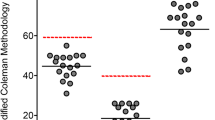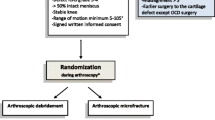Abstract
Purpose
The purpose of this study was to describe the practice of microfracture surgery for knee chondral defects among Canadian orthopedic surgeons.
Methods
All orthopedic surgeon members of the Canadian Orthopaedic Association were invited to participate in a survey, designed to explore the microfracture technique used by orthopedic surgeons in the treatment for knee chondral defects The primary outcome measure was an emailed 26-item questionnaire, which explored indications for microfracture surgery, surgical techniques, types of postoperative rehabilitation regimes used and assessment of outcome. In addition, responses were compared between orthopedic surgeons with a sports medicine practice to surgeons with a non-sports medicine practice.
Results
The survey response rate was 24.6% (299/1,216), with 131 regularly performing microfracture. 41% of surgeons indicated that they had no upper limit for age at the time of surgery, and 87% indicated no upper limit for body mass index. The majority of respondents (97%) resected cartilage back to a stable margin, while 69% of respondents removed the calcified cartilage layer prior to creating holes. Only 11% of respondents used continuous passive motion (CPM) postoperatively, and 39% did not restrict weight bearing. Sports surgeons were more likely than non-sports surgeons to remove the calcified cartilage layer, use a 45° pick, use CPM and restrict weight bearing postoperatively (all P values < 0.05).
Conclusions
This survey on microfracture for knee chondral defects revealed widespread variation among surgeons regarding the indications for surgery, surgical technique, postoperative rehabilitation and assessment of outcome. Sports surgeons demonstrate better evidence-based practice than non-sports surgeons for a few important parameters.
Level of evidence
Cross-sectional survey, Level II.







Similar content being viewed by others
References
Asik M, Ciftci F, Sen C, Erdil M, Atalar A (2008) The microfracture technique for the treatment of full-thickness articular cartilage lesions of the knee: midterm results. Arthroscopy 24:1214–1220
Basad E, Ishaque B, Bachmann G, Sturz H, Steinmeyer J (2010) Matrix-induced autologous chondrocyte implantation versus microfracture in the treatment of cartilage defects of the knee: a 2-year randomised study. Knee Surg Sports Traumatol Arthrosc 18:519–527
Bedi A, Feeley BT, Williams RJ 3rd (2010) Management of articular cartilage defects of the knee. J Bone Jt Surg Am 92:994–1009
Blevins FT, Steadman JR, Rodrigo JJ, Silliman J (1998) Treatment of articular cartilage defects in athletes: an analysis of functional outcome and lesion appearance. Orthopedics 21:761–767
Brittberg M, Lindahl A, Nilsson A, Ohlsson C, Isaksson O, Peterson L (1994) Treatment of deep cartilage defects in the knee with autologous chondrocyte transplantation. N Engl J Med 331:889–895
Buckwalter JA (1999) Evaluating methods for restoring cartilaginous articular surfaces. Clin Orthop Relat Res 367S:S224–S238
Buckwalter JA, Mankin HJ (1997) Articular cartilage: part II, degeneration and osteoarthrosis, repair, regeneration, and transplantation. J Bone Jt Surg Am 79:612–632
Chen H, Sun J, Hoemann CD, Lascau-Coman V, Ouyang W, McKee MD, Shive MS, Buschmann MD (2009) Drilling and microfracture lead to different bone structure and necrosis during bone-marrow stimulation for cartilage repair. J Orthop Res 27:1432–1438
Freemont AJ, Hoyland J (2006) Lineage plasticity and cell biology of fibrocartilage and hyaline cartilage: Its significance in cartilage repair and replacement. Eur J Radiol 57:32–36
Frisbie DD, Oxford JT, Southwood L, Trotter GW, Rodkey WG, Steadman JR, Goodnight JL, McIlwraith CW (2003) Early events in cartilage repair after subchondral bone microfracture. Clin Orthop Relat Res 407:215–227
Frisbie DD, Morisset S, Ho CP, Rodkey WG, Steadman JR, McIlwraith CW (2006) Effects of calcified cartilage on healing of chondral defects treated with microfracture in horses. Am J Sports Med 34:1824–1831
Gill TJ (2000) The treatment of articular cartilage defects using microfracture and debridement. Am J Knee Surg 13:33–40
Gobbi A, Nunag P, Malinowski K (2005) Treatment of chondral lesions of the knee with microfracture in a group of athletes. Knee Surg Sports Traumatol Arthrosc 13:213–221
Gudas R, Kalesinskas RJ, Kimtys V, Stankevicius E, Toliusis V, Bernotavicius G, Smailys A (2005) A prospective randomized clinical study of mosaic osteochondral autologous transplantation versus microfracture for the treatment of osteochondral defects in the knee joint in young athletes. Arthroscopy 21:1066–1075
Harris JD, Brophy RH, Siston RA, Flanigan DC (2010) Treatment of chondral defects in the athlete’s knee: systematic review. Arthroscopy 6:841–852
Heir S, Aroen A, Loken S, Holme I, Engebretsen L, Reinholt F (2012) Cartilage repair in the rabbit knee; mosaicplasty results in higher degree of tissue filling but affected subchondral bone more than microfracture technique. A blinded, randomized, controlled, long-term follow-up in 88 knees. Knee Surg Sports Truamatol Arthrosc 20:197–209
Knutsen G, Engebretsen L, Ludvigsen TC, Drogset JO, Grøntvedt T, Solheim E, Strand T, Roberts S, Isaksen V, Johansen O (2004) Autologous chondrocyte implantation compared with microfracture in the knee: a randomized trial. J Bone Jt Surg Am 86:455–464
Knutsen G, Drogset JO, Engebretsen L, Grøntvedt T, Isaksen V, Ludvigsen TC, Roberts S, Solheim E, Strand T, Johansen O (2007) A randomized trial comparing autologous chondrocyte implantation with microfracture: findings at five years. J Bone Jt Surg Am 89:2105–2112
Kreuz PC, Erggelet C, Steinwachs MR, Krause SJ, Lahm A, Niemeyer P, Ghanem N, Uhl M, Sudkamp N (2006) Is microfracture of chondral defects in the knee associated with different results in patients aged 40 years or younger? Arthroscopy 22:1180–1186
Kreuz PC, Steinwachs MR, Erggelet C, Krausey SJ, Konrad G, Uhl M, Sudkamp N (2006) Results after microfracture of full-thickness chondral defects in different compartments in the knee. Osteoarthritis and Cartilage 14:1119–1125
Mandelbaum BR, Browne JE, Fu F, Micheli L, Mosely JB Jr, Erggelet C, Minas T, Peterson L (1998) Articular cartilage lesions in the knee. Am J Sports Med 26:853–861
Marder RA, Hopkins G, Timmerman LA (2005) Arthroscopic microfracture of chondral defects of the knee: a comparison of two postoperative treatments. Arthroscopy 21:152–158
Matsunaga D, Akizuki S, Takizawa T, Yamazaki I, Kuraishi J (2007) Repair of articular cartilage and clinical outcome after osteotomy with microfracture or abrasion arthroplasty for medial gonarthrosis. Knee 14:465–471
Mithoefer K, Williams RJ 3rd, Warren RF, Potter HG, Spock CR, Jones EC, Wickiewicz TL, Marx RG (2005) The microfracture technique for the treatment of articular cartilage lesions in the knee: a prospective cohort study. J Bone Jt Surg Am 87:1911–1920
Mithoefer K, Williams RJ 3rd, Warren RF, Wickiewicz TL, Marx RG (2006) High-impact athletics after knee articular cartilage repair: a prospective evaluation of the microfracture technique. Am J Sports Med 34:1413–1418
Mithoefer K, Williams RJ 3rd, Warren RF, Potter HG, Spock CR, Jones EC, Wickiewicz TL, Marx RG (2006) Chondral resurfacing of articular cartilage defects in the knee with the microfracture technique: surgical technique. J Bone Jt Surg Am 88(Suppl 1 Pt 2):294–304
Mussa R, Hans MG, Enlow D, Goldberg J (1999) Condylar cartilage response to continuous passive motion in adult guinea pigs: a pilot study. Am J Orthod Dentofacial Orthop 115:360–367
Rodrigo JJ, Steadman JR et al (1994) Improvement of full thickness chondral defect healing in the human knee after debridement and microfracture using continuous passive motion. Am J Knee Surg 7:109–116
Salter RB (1994) The physiologic basis of continuous passive motion for articular cartilage healing and regeneration. Hand Clin 10:211–219
Steadman JR, Briggs KK, Rodrigo JJ, Kocher MS, Gill TJ, Rodkey WG (2003) Outcomes of microfracture for traumatic chondral defects of the knee: average 11-year follow-up. Arthroscopy 19:477–484
Steadman JR, Ramappa AJ, Maxwell RB, Briggs KK (2007) An arthroscopic treatment regimen for osteoarthritis of the knee. Arthroscopy 23:948–955
Steadman JR, Rodkey WG, Rodrigo JJ (2001) Microfracture: surgical technique and rehabilitation to treat chondral defects. Clin Orthop Relat Res 391(Suppl):S362–S369
Steadman JR, Rodkey WG, Singleton SB, Briggs KK (1997) Microfracture technique for full-thickness chondral defects: technique and clinical results. Oper Tech Orthop 7:300–304
Strauss E, Schacter A, Frenkel S, Rosen J (2009) The efficacy of intra-articular hyaluronan injection after the microfracture technique for the treatment of articular cartilage lesions. Am J Sports Med 37:720–726
Tran-Khanh N, Hoemann CD, McKee MD, Henderson JE, Buschmann MD (2005) Aged bovine chondrocytes display a diminished capacity to produce a collagen-rich, mechanically functional cartilage extracellular matrix. J Orthop Res 23:1354–1362
Vasiliadis HS, Wasiak J (2010) Autologous chondrocyte implantation for full thickness articular cartilage defects of the knee. Cochrane Database Syst Rev 10:CD003323
Williams JM, Moran M, Thonar EJ, Salter RB (1994) Continuous passive motion stimulates repair of rabbit knee articular cartilage after matrix proteoglycan loss. Clin Orthop Relat Res 304:252–262
Williams RJ 3rd, Harnly HW (2007) Microfracture: indications, technique, and results. Instr Course Lect 56:419–428
Acknowledgments
This study was supported by Canadian Arthritis Network Grant.
Author information
Authors and Affiliations
Corresponding author
Rights and permissions
About this article
Cite this article
Theodoropoulos, J., Dwyer, T., Whelan, D. et al. Microfracture for knee chondral defects: a survey of surgical practice among Canadian orthopedic surgeons. Knee Surg Sports Traumatol Arthrosc 20, 2430–2437 (2012). https://doi.org/10.1007/s00167-012-1925-6
Received:
Accepted:
Published:
Issue Date:
DOI: https://doi.org/10.1007/s00167-012-1925-6




